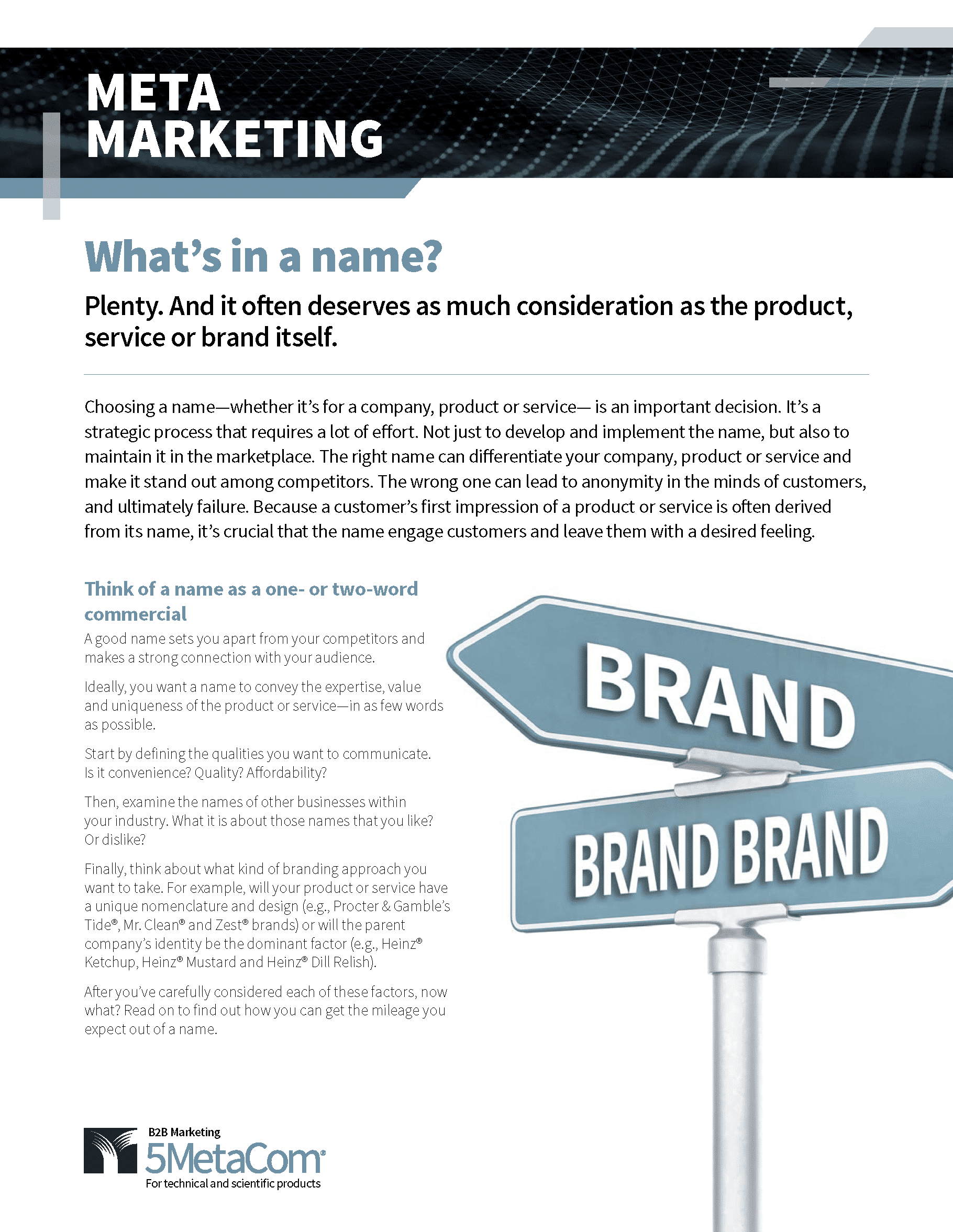What’s in a name?
Plenty. And it often deserves as much consideration as the product, service or brand itself.
Choosing a name—whether it’s for a company, product or service— is an important decision. It’s a strategic process that requires a lot of effort. Not just to develop and implement the name, but also to maintain it in the marketplace. The right name can differentiate your company, product or service and make it stand out among competitors. The wrong one can lead to anonymity in the minds of customers, and ultimately failure. Because a customer’s first impression of a product or service is often derived from its name, it’s crucial that the name engage customers and leave them with a desired feeling.
Think of a name as a one- or two-word commercial
A good name sets you apart from your competitors and makes a strong connection with your audience.
Ideally, you want a name to convey the expertise, value and uniqueness of the product or service—in as few words as possible.
Start by defining the qualities you want to communicate. Is it convenience? Quality? Affordability?
Then, examine the names of other businesses within your industry. What it is about those names that you like? Or dislike?
Finally, think about what kind of branding approach you want to take. For example, will your product or service have a unique nomenclature and design (e.g., Procter & Gamble’s Tide®, Mr. Clean® and Zest® brands) or will the parent company’s identity be the dominant factor (e.g., Heinz® Ketchup, Heinz® Mustard and Heinz® Dill Relish).
After you’ve carefully considered each of these factors, now what? Read on to find out how you can get the mileage you expect out of a name.


What makes a great name?
Great names support the overall brand strategy and are memorable. Some names suggest the category in which the brand operates. Others describe the brand’s benefits. Still others, made-up concoctions, act as empty vessels that can be filled with meaning and positive associations. Regardless of the type, a strong name can help strengthen a brand, and if properly managed, it can become an increasingly valuable asset.
Five characteristics of a great name
1. A great name must support the brand strategy
Marketing research shows the most effective names clearly communicate the key attributes of the company, product or service they represent.
Think of it in terms of this: If you knew nothing about the brand, what would the name alone communicate? Does it convey the proper message? Is it aligned with the qualities that you want your company, product or service identified with?
2. A great name must be easy to use
How easily a name “rolls off the tongue” can have a significant impact on its appeal with audiences, thus it’s important to consider many criteria:
- Is it easy to pronounce?
- Does everyone pronounce it the same way?
- Is it spoken the way it’s written?
- Is it short and simple?
- Can it be said and understood, without having to spell it?
- Is it pleasing when read and heard?
3. A great name must be memorable
Memorability can have a significant impact on the value and effectiveness of a name. A memorable name is strong in terms of the mental images it conjures up in the minds of audiences, yet is simple enough to not be confusing.
A good measure of the memorability of a name can be found in the answers to the questions in #2 above. If you can answer “yes” to most of them, then the name you’ve selected is well on its way to becoming more recognizable, and therefore more likely to be remembered by audiences.
4. A great name must fit with existing nomenclature (if applicable)
For companies that already have an established method for naming products or services, it’s important that new names build upon that tradition. Not doing so would result in a lost opportunity for strengthening the overall brand. Companies that don’t already have established nomenclature should consider how they’ll approach the naming process, now and in the future.
5. A great name must be ownable
When examining name options, it’s important for companies to know whether they have the legal right to use it. A thorough trademark search, done early in the process, can help companies identify potential conflicts and save them from wasting valuable resources on unattainable names.
Once you’ve decided on a name, it’s equally as important to register it as a trademark. Doing so identifies a company, product or service in the marketplace and helps distinguish it from competitive offerings. The registration process should be complete before you spend any money on stationery, signage or advertising.
Best letters for names
When developing a name, it’s also important to consider the letters you use in it.
Why? Because some letters are stronger than others and can convey certain positive connotations. For example:
- Q is unique and has a strong identity
- V, X and Z are often associated with cutting-edge products
- M gives words a softer, more embracing feeling
- Hard consonants such as K are more attention-getting and memorable
Name categories
As you begin to develop names, it’s helpful to organize them into different categories—each representing distinctly different characteristics. In doing so, you’ll find that some will fit into only one category, while others may have traits from two or more groups. This process can help you zero in on names that have the qualities you think are most important.
Although there are many ways to classify names, most fall into one of the following five categories.

Acronyms vs. abbreviations: What’s the difference?
All acronyms are abbreviations, but not all abbreviations are acronyms. An acronym is formed from the initial letters of a name and is pronounced as a new word (e.g., Wi-Fi – wireless fidelity).
On the other hand, an abbreviation is a combination of letters that stand for a phrase and is said letter-by-letter (e.g., AT&T – American Telephone and Telegraph).

Avoiding the gravitationally completely collapsed object of anonymity

Not convinced that shorter, more concise names are more powerful than longer, more complicated ones? Then consider this paradigm:
We all know what a “gravitationally completely collapsed object” is, yet almost none of us realize it. And chances are slim that any of us has ever heard the phrase used in everyday conversation.
That’s because most people refer to it by its more commonly used name—black hole— which was coined by theoretical physicist John Wheeler in 1967.
The shorter, more concise “black hole” successfully attracted attention and quickly gained popularity. Today, “black hole” returns nearly 36,180,000 times more hits on the internet than the longer version. While it’s only one of many examples, the “black hole” moniker clearly demonstrates how shorter, more memorable names add even more marketing power and interest.
So the next time you’re tempted to name a product, brand or service using highly complex jargon, resist the urge and avoid having it fall into the “black hole” of anonymity.
Elements of design
The visual representation of a name plays a major role in brand recognition and recall. Thus, when developing a visual identity—or logo—for a name, the challenge is to balance the core messaging of the brand with unique design elements that support the overall brand strategy.
How well these elements work together is an important factor in how audiences perceive the brand. There are many different ways to combine these elements to create a lasting impression. A single component can dominate the logo. Or you can combine two to create tension and excitement. Or you can blend all of them together to produce a more subtle feeling.
Regardless of which style you choose, the #1 goal should always be to portray the company, product or service in a positive and professional way.
Images
Whether it is a photograph, line art or computer-generated design, an image can add a significant amount of personality to a brand. Art directors who combine their creativity with today’s cutting-edge computer programs can turn otherwise ordinary ideas into distinctive elements that contribute to a brand’s uniqueness and character. The consistent use of these elements is what helps define the brand and set it apart from its competitors.

Typography
As one of the oldest design elements, typography plays an integral role in defining a brand’s personality. With thousands of fonts to choose from, it’s important to select typefaces that are captivating, yet are easy to read. Companies that can’t find existing fonts that meet their needs may choose to create their own.
Fonts can appear in various shapes and sizes to convey certain messages. For example, a bolder font may be used to denote power or strength, while a thinner font can convey style and elegance. As with illustrations, it’s important for fonts to be used consistently across all communications to create familiarity among audiences.

Color
Colors complement and contrast one another, and, when used in the right combination, can subtly reinforce the personality of a brand.
For instance, blue is often associated with the sky, heaven and water; it suggests serenity, but it can also imply cold, authoritative or technical. Red is the color of blood; it represents courage and romance, but it can also signify hot, commanding or alert.
Because colors convey different emotions, moods and meanings, it’s important to choose a color palette that communicates precisely the right message and supports the overall brand strategy.

Naming no-no’s
Naming a product, process or service can be one of the most challenging endeavors a company can ever face. To get it right, companies must often invest a lot of resources. Some decide to skip the process altogether.
But choosing not to name something can result in a lost opportunity—making it one of the biggest mistakes a company can make. Other costly errors include:

- Waiting too long to begin the naming process
- Not registering a name or aggressively protecting its trademark
- Naming a product after its technology, instead of something that resonates with customers
- Choosing a name that has internal meaning, but no external meaning
- Selecting a name that is difficult to pronounce, spell or use
- Limiting a name to a geographic location or industry (e.g., Tulsa Tool and Die)
- Failing to test a name with target audiences, instead relying on internal feedback only
- Having unrealistic expectations for a name (e.g., expecting the name to do it all)
- Insisting that the full, legal company name be used on individual products, processes or services
